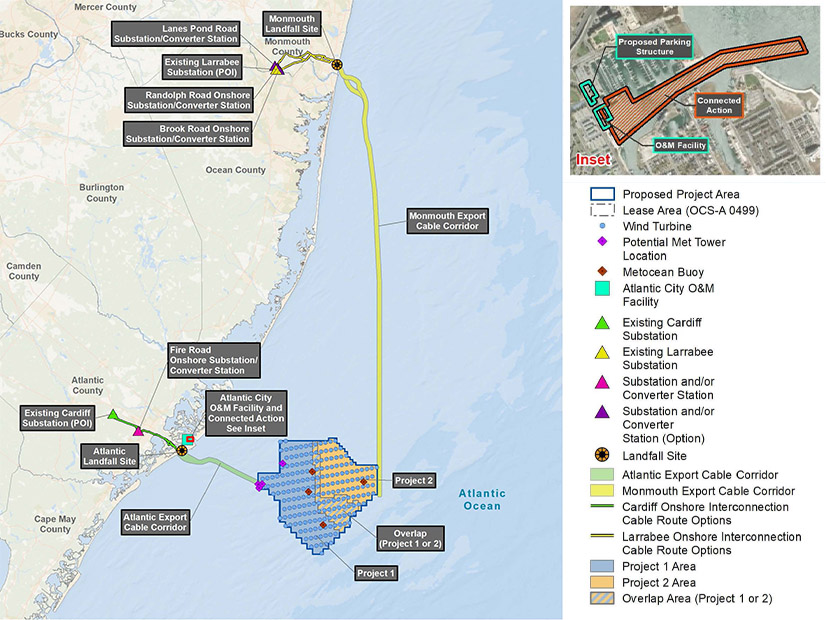The Bureau of Ocean Energy Management released its final environmental impact statement (FEIS) May 23 that concludes that New Jersey’s foremost offshore wind project, Atlantic Shores, would have a “major” impact on commercial and for-hire recreational fishing, the view from the shore and on-ship traffic.
The 560-page study found that the 200-turbine, 1,510-MW project would impact the commercial and recreational fishing sector through a range of activities, including anchoring, cable emplacement, noise, port use and structure presence. At about 10 miles from the shore, Atlantic Shores is the closest OSW project in development to the land in New Jersey.
But the FEIS also concludes the area would suffer a major impact even if the project were not constructed. Those impacts would stem from factors including fishery management measures taken to ensure that the volume of fish caught is sustainable; the impact of climate change from ocean warming, sea level rise and ocean acidification; and non-OSW construction on land.
Likewise, the study found that although the project would have a major scenic impact on the area — on the open ocean, seascape, and landscape character and views — the coast would suffer a strong scenic impact regardless because of onshore development and construction activities, offshore vessel traffic and the effects of other OSW projects.
And the agency found that the impact of the project on most of the other 19 categories studied — including recreation and tourism, land use and costal infrastructure, water and air quality, and a variety of animal species — would be moderate or minor.
BOEM compiles EIS reports to assess the potential impacts from an OSW project on physical, biological, socioeconomic and cultural resources. The final report informs BOEM’s decision on whether to approve, approve with modifications or disapprove the project’s Construction and Operations Plan (COP), and the FEIS may also be used by other agencies in evaluating the project.
The FEIS evaluates the impact on the area if the project does not go ahead and if the project goes ahead as planned. The agency also looks at the impact if the project were reshaped or adjusted to try to mitigate any effects, such as by reducing the number of turbines or their position in the lease area. But any such adjustments did not generally reduce the impacts of Atlantic Shores that BOEM assessed as “major.”
In response to the release of the FEIS, Atlantic Shores said it “remains dedicated to responsible development [and] environmental stewardship.”
“We are encouraged to see forward progress and getting another step closer to delivering New Jersey’s first offshore wind projects,” said CEO Joris Veldhoven. “We appreciate BOEM’s thorough environmental evaluation and recognize the significance of this milestone.”
Tourism, Whale Impact
Atlantic Shores, a 50/50 joint venture between EDF-RE Offshore Development and Shell New Energies US, was one of two projects — along with Danish developer Ørsted’s Ocean Wind 2 — that the New Jersey Board of Public Utilities approved in its second solicitation in 2021. That followed the agency’s approval in 2019 of Ørsted’s Ocean Wind 1 project. (See NJ Awards Two Offshore Wind Projects.)
Ørsted has abandoned its two projects, saying they were no longer feasible.
New Jersey approved two more projects in its third solicitation, and the combined total of those two and Atlantic Shores would, if completed, account for slightly less than half the state goal of 11 GW of OSW capacity by 2040. The state in April opened a fourth solicitation. (See New Jersey Opens 4th Offshore Wind Solicitation.)
Critics of the projects are concerned about the impact on the commercial fishing and tourism sectors and on the quality of life to local homeowners, especially from an impaired view of the sea.
The study also found the project would have only a minor impact on the tourism industry.
Navigation and vessel traffic in the area would suffer only a moderate impact if Atlantic Shores were not built, but a major impact if it were because of “increased vessel traffic in and near the project area and on the approach to ports used,” according to the report. Traffic would especially increase during the construction period, and the impacts would include “changes to navigational patterns and to the effectiveness of marine radar and other navigation tools” that could result in “delays within or approaching ports, increased navigational complexity [and] detours to offshore travel or port approaches,” the study says.
The study found the project would have only a moderate impact on most mammals but would have a major impact on the North Atlantic right whale, which is an endangered species. That assessment stemmed from the fact that “impacts on individual NARWs could have severe population-level effects and compromise the viability of the species due to their low population numbers and continued state of decline,” the report said.
Opponents of OSW projects regularly cite a series of whale deaths on the Jersey Shore as potentially caused by preliminary OSW activities. But construction has yet to begin on any project in the state, and federal and state investigators have found no link between the deaths and OSW activities, saying they are most likely caused by vessels hitting the whales.


